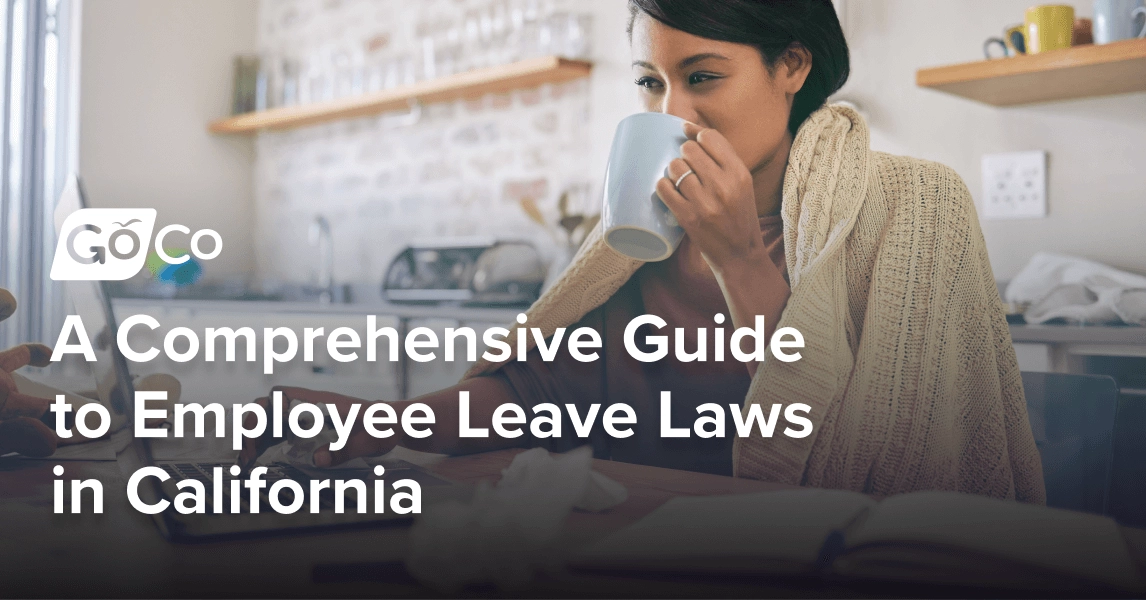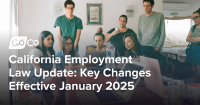A Comprehensive Guide to Employee Leave Laws in California
Navigate California's employee leave laws, including paid sick leave, CFRA, and PDL, to ensure compliance and support your workforce.
October 4th, 2024
Some organizations are staying ahead of the curve by ensuring they provide various forms of time off that prioritize well-being and family care.
As an employer in California, it's crucial to understand the state's comprehensive employee leave laws to ensure compliance and support your workforce.
In this blog, we'll dive into the specifics of paid sick leave requirements under California law.
Understanding Paid Sick Leave in California
California's Healthy Workplaces, Healthy Families Act (HWHFA) mandates that employers provide paid sick leave to their employees. This law sets forth specific accrual and usage requirements that employers must adhere to in order to comply with California's Paid Sick Leave Law.
Under the act, employees accrue paid sick leave at a rate of one hour for every 30 hours worked. Employers can cap accrual at 48 hours or six days per year, and can limit the use of paid sick leave to 24 hours or three days per year. However, employers may choose to provide more generous paid sick leave policies.
Covered Employers and Employees
Nearly all employers in California, regardless of size, are required to provide paid sick leave to their employees. This includes businesses, non-profits, and public entities. The law applies to all employees who work in California for 30 or more days within a year, including part-time, temporary, and seasonal workers.
It's important to stay informed about how employment law updates may impact employee eligibility for paid sick leave. For example, changes to the definition of a covered employee or modifications to accrual rates could affect your company's paid sick leave obligations.
Permitted Uses of Paid Sick Leave
Employees can use their accrued paid sick leave for a variety of reasons, as outlined in the Paid Sick Leave in California guidelines.
These include:
Diagnosis, care, or treatment of an existing health condition for the employee or a covered family member
Preventive care for the employee or a covered family member
Time off due to domestic violence, sexual assault, or stalking
For the purposes of paid sick leave, covered family members include:
Spouse or registered domestic partner
Child (biological, adopted, foster, step, legal ward, or child to whom the employee stands in loco parentis)
Parent (biological, adoptive, foster, step, legal guardian, or person who stood in loco parentis to the employee when the employee was a minor child)
Grandparent
Grandchild
Sibling
California Family Rights Act (CFRA) Leave
The California Family Rights Act (CFRA) is a state law that provides eligible employees with job-protected leave for certain family and medical reasons. It is designed to help employees balance their work and family responsibilities by allowing them to take time off work to care for themselves or their family members without fear of losing their job.
The CFRA is similar to the federal Family and Medical Leave Act (FMLA) in many ways, but there are some key differences. For example, the CFRA applies to more employers than the FMLA, and it provides leave for additional family members, such as siblings, grandparents, and grandchildren.
CFRA Employer Coverage and Employee Eligibility
The CFRA applies to private employers with five or more employees, as well as all public employers in California, regardless of the number of employees. This is a broader coverage than the FMLA, which applies to employers with 50 or more employees.
To be eligible for CFRA leave, an employee must have worked for their employer for at least 12 months and have worked at least 1,250 hours in the 12 months before the leave begins. This is the same eligibility requirement as the FMLA.
Employers should be aware of their obligations under both the CFRA and FMLA, as well as any paid parental leave policies they may have in place.
CFRA Qualifying Events and Leave Duration
Under the CFRA, eligible employees can take up to 12 weeks of unpaid, job-protected leave in a 12-month period for the following reasons:
The birth of a child or placement of a child for adoption or foster care.
To care for an employee's spouse, domestic partner, child, parent, grandparent, grandchild, or sibling with a serious health condition.
For an employee's own serious health condition that makes them unable to perform their job duties.
For a qualifying exigency related to the covered active duty or call to covered active duty of an employee's spouse, domestic partner, child, or parent in the US Armed Forces.
Employers must maintain an employee's health benefits during CFRA leave, and employees must be restored to their same or a comparable position upon return from leave.
Managing medical leaves of absence in California can be complex, as employers must navigate both state and federal laws. It's crucial for employers to stay up-to-date on the latest developments and seek legal counsel when necessary to ensure compliance.
Pregnancy Disability Leave (PDL) in California
Pregnancy Disability Leave (PDL) is a California law that provides job-protected leave for employees who are disabled due to pregnancy, childbirth, or related medical conditions. PDL is separate from the CFRA and applies to employers with five or more employees.
Under PDL, eligible employees are entitled to up to four months of unpaid leave per pregnancy. This leave can be taken continuously or intermittently, as needed for the employee's health condition. Employees must provide reasonable notice of their need for leave, and employers may require medical certification to support the request.
To be eligible for PDL, an employee must work for a covered employer and have a medical condition related to pregnancy or childbirth that prevents them from performing essential job functions. There is no minimum length of service or hours worked requirement for PDL eligibility.
Interaction of PDL with CFRA and FMLA in California
PDL, CFRA, and FMLA can intersect in various ways for pregnant employees in California. It's essential for employers to understand how these leave laws interact to ensure compliance and protect employee rights.
PDL provides leave for pregnancy-related disabilities, while CFRA and FMLA provide leave for bonding with a new child and other family and medical reasons.
Employees may be eligible for PDL in addition to CFRA and FMLA leave, depending on their individual circumstances.
PDL can run concurrently with FMLA leave if the employee is eligible for both and the employer designates the leave as such.
After exhausting PDL, an employee may be eligible for additional leave under CFRA for baby bonding or other qualifying reasons.
Here are a few examples to illustrate the interplay of these leave laws:
An employee who is disabled due to pregnancy takes 12 weeks of PDL. After giving birth, she takes an additional 12 weeks of CFRA leave for baby bonding, for a total of 24 weeks of job-protected leave.
An employee takes 8 weeks of PDL before giving birth and 4 weeks after. She then takes 12 weeks of FMLA leave for baby bonding, running concurrently with her remaining PDL and CFRA leave.
An employee exhausts her 16 weeks of PDL before giving birth. After delivery, she is eligible for 12 weeks of CFRA leave for baby bonding.
Employers should carefully track employee leaves using time off software to ensure compliance with all applicable laws and to avoid overlapping or duplicating leave entitlements. It's also essential to communicate clearly with employees about their leave options and to coordinate benefits such as health insurance and accrued paid time off during periods of leave.
Other California Leave Laws and Protections
In addition to the CFRA, FMLA, and PDL, California has several other leave laws that provide employees with time off for specific purposes. These include kin care leave, which allows employees to use a portion of their accrued sick leave to care for a family member, and school activities leave, which provides time off for parents to participate in their children's school activities.
California law also requires employers to provide leave as a reasonable accommodation for employees with disabilities under the Fair Employment and Housing Act (FEHA). This means that employers must engage in an interactive process with employees who request leave due to a disability to determine whether the leave can be granted without causing undue hardship to the employer.
Workers' Compensation and Leave Rights in California
Employees who suffer work-related injuries or illnesses may be entitled to leave under California's workers' compensation laws. These laws provide for medical treatment, temporary disability benefits, and other benefits for employees who are unable to work due to a work-related injury or illness.
It's important to note that workers' compensation leave may interact with other leave laws, such as the FMLA and CFRA. Employers must be aware of these interactions and ensure that they are complying with all applicable laws.
HR compliance software can help employers navigate these complex legal requirements and ensure that they are providing the appropriate leave benefits to their employees.
California has a wide range of leave laws that provide employees with time off for various purposes, including family care, school activities, and work-related injuries or illnesses. Employers must be familiar with these laws and ensure that they are complying with all applicable requirements.
Complying with California's Leave Laws
Navigating the complex web of California's leave laws can be a daunting task for employers. However, by implementing best practices and staying informed about legal requirements, businesses can effectively manage employee leaves of absence while maintaining compliance.
One crucial aspect of leave management is accurate recordkeeping. Employers must maintain detailed records of employee leave requests, approvals, and usage. Utilizing employee time tracking systems can streamline this process and ensure that leave balances are accurately tracked and updated in real-time.
Additionally, employers must familiarize themselves with notice requirements for various types of leave, especially on city, local, and municipal levels. For example, under the Paid Sick Leave Ordinance, employers in San Francisco must provide employees with a written notice of their sick leave rights at the time of hire and display a poster in a conspicuous location at the workplace.
Avoiding Common Leave Law Pitfalls
Despite best efforts, employers may inadvertently make mistakes when administering employee leave.
Some frequent pitfalls include:
Failing to provide required notices and disclosures to employees
Incorrectly calculating leave entitlements or accrual rates
Denying leave requests without proper justification
Retaliating against employees for exercising their leave rights
To minimize legal risks and ensure compliance, employers should:
Regularly review and update leave policies to align with current laws
Train managers and supervisors on leave administration procedures
Communicate leave policies clearly to employees
Document all leave requests, approvals, and denials
Seek legal counsel when faced with complex leave situations
By proactively addressing these common pitfalls and implementing best practices, employers can navigate California's leave laws with confidence and foster a supportive work environment for their employees.
Navigating Local Leave Ordinances in California
California is known for its progressive labor laws, and this extends to employee leave. While the state has several mandates in place, such as the CFRA and the HWHFA, many cities and counties have their own leave ordinances that provide additional benefits to employees.
For example, San Francisco has its own Paid Parental Leave Ordinance (PPLO) that requires employers to supplement the benefits provided by the state's Paid Family Leave (PFL) program.
Complying with both state and local leave requirements can be challenging for employers, especially those with employees in multiple locations. It's essential to stay informed about the specific leave laws that apply to your business and to have systems in place to manage leave requests and track employee absences.
Determining Which Leave Law Applies
When multiple leave laws apply to an employee, the general rule is that the most generous provision prevails. This means that if a local ordinance provides a greater benefit than the state law, the employer must comply with the local ordinance.
For example, let's say an employee in San Francisco requests paid parental leave. Under the CFRA, the employee is entitled to up to 12 weeks of unpaid leave. However, under San Francisco's PPLO, the employee is entitled to receive supplemental compensation from their employer during the period of PFL benefits. In this case, the employer must comply with both the CFRA's job protection requirements and the PPLO's compensation requirements.
Navigating the interaction of state and local leave laws can be complex, but an all-in-one HR platform can help. By centralizing leave requests and tracking, HR professionals can ensure compliance with all applicable laws and provide a seamless experience for employees.
Leave Law Resources for California Employers
Navigating the complex landscape of employee leave laws in California can be challenging for employers. To ensure compliance and stay informed about the latest developments, it's essential to have reliable resources at your fingertips.
Here are some key government agencies and websites that provide valuable information on leave laws:
California Department of Fair Employment and Housing (DFEH): The DFEH is responsible for enforcing state laws that prohibit discrimination, harassment, and retaliation in employment, including those related to leave. Their website offers guidance, resources, and complaint filing procedures.
California Labor Commissioner's Office: Also known as the Division of Labor Standards Enforcement (DLSE), this agency oversees and enforces labor laws, including those pertaining to leave. They provide information on various leave entitlements, such as paid sick leave and family leave.
California Employment Development Department (EDD): The EDD administers several leave programs, including Paid Family Leave (PFL) and State Disability Insurance (SDI). Their website offers detailed information on eligibility, benefits, and the application process for these programs.
U.S. Department of Labor (DOL): While not specific to California, the DOL enforces federal leave laws, such as the Family and Medical Leave Act (FMLA). Their website provides comprehensive resources, fact sheets, and compliance assistance materials.
To stay updated on leave law developments and best practices, consider the following recommendations:
Regularly check the websites mentioned above for updates, news releases, and new guidance materials.
Subscribe to email updates or newsletters from these agencies to receive timely information directly in your inbox.
Attend webinars, seminars, or training sessions offered by government agencies, legal experts, or industry associations to deepen your understanding of leave laws and their practical implications.
Consult with legal counsel specializing in employment law to ensure your leave policies and practices are compliant and up-to-date.
Utilize an HRIS to streamline leave management, track employee eligibility, and maintain accurate records. These tools can help you stay organized and compliant with various leave requirements.
Regularly review and update your leave policies to reflect any changes in the law or best practices. Communicate these updates to your employees and provide training as needed.
By leveraging these resources and staying proactive in your approach to leave management, you can navigate the complex web of California leave laws with greater confidence and minimize the risk of non-compliance.
As you navigate the complex landscape of employee leave laws in California, remember that you don't have to go it alone.
Our team at GoCo is here to support you with our all-in-one HR platform, designed to simplify leave management and ensure compliance. Book a demo today and discover how we can help you streamline your HR processes, so you can focus on what matters most – your people.
Recommended Posts
A Complete Guide to California SB 553 Compliance
Blog Articles
New Hire Paperwork and Compliance for California
Blog Articles
Search...
Product
GoCo
Resources
Articles
eBooks
Webinars
Customer Stories





